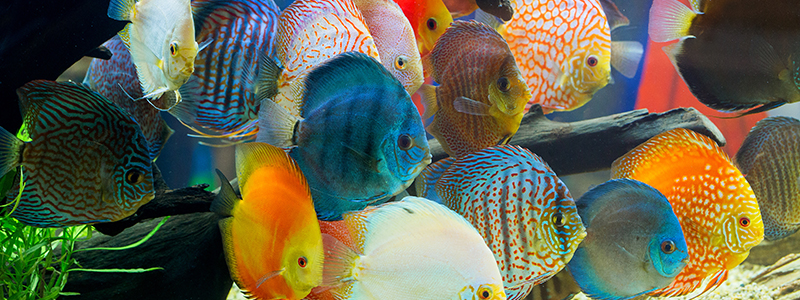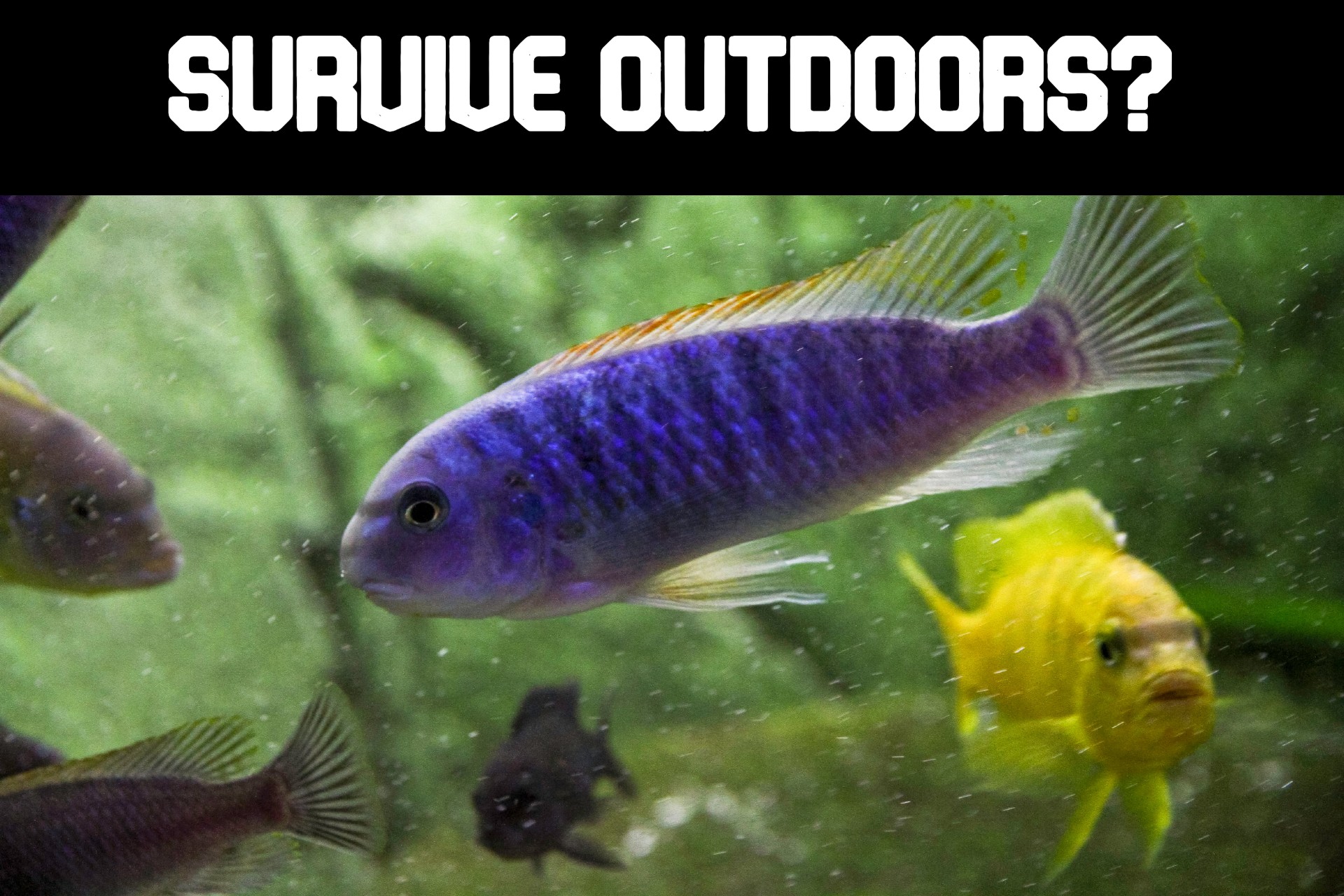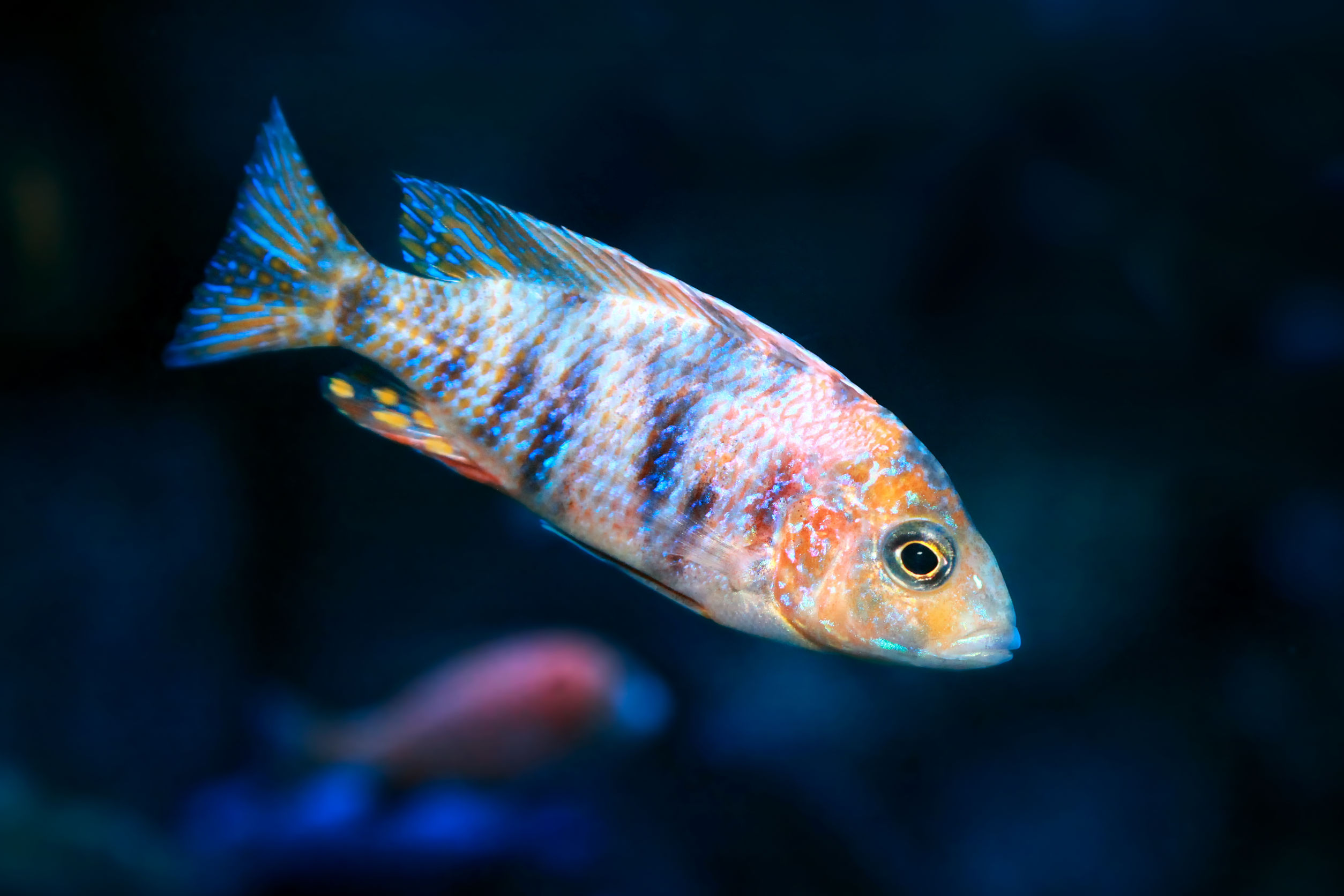Think about the most colorful and active freshwater fish at your local fish store. I bet at least one of those fish was a type of cichlid – African, South American, or Central American. Their lively personalities, long lives, and bright colors make them popular fish. You may have heard stories about cichlids being hard to care for…but is that true? Are cichlids hard to care for, for the average aquarist?
Cichlids are rated as intermediate, which means they’re a little tougher to care for than some fish. But if you’ve kept fish before and they didn’t die on you, then you’re ready for these colorful and exciting fish! In this article, I’ve got some tips and tricks for keeping your new cichlids happy and healthy.
Cichlid Tank Set-Up
Let’s start with the basics of keeping cichlids—the proper size tank, kinds of decorations or plants, necessary equipment, and water parameters.
1. Tank Size
This depends on which type you decide to get since they can grow up to 36 inches long, though the most popular varieties stay between four and eight inches. The general rule of thumb is to have two gallons of water for every inch of fish, so if you were keeping a six-inch cichlid, you’d need a 12-gallon tank at a minimum.
But you probably don’t want to keep just one fish—so plan how many cichlids like to keep in your tank, then look at the adult length for each cichlid, and multiply all the adult lengths by two. For example, I want to have six cichlids in my tank, and they’re each going to be four inches long. That’s 24 inches of fish, or 48 gallons of water (24 total inches of fish times two gallons per inch).
Cichlids are territorial, you’ll have problems if your tank is too small for the number of fish you have. Each cichlid needs to feel like they have its own special territory or area of the tank. If the tank is too small for that to happen, they could start fighting with each other.
Tank size is one reason cichlids aren’t recommended for beginners—you need to have a fairly large tank to house these lively fish, and they like lots of room to swim around.
In addition, you need to add plenty of décors, which I look at next.
2. Décor
To make your cichlids really feel at home in their spacious tank, you’ll want to add several hiding places for them. Not only will this help the shyer fish in your tank, but it will also give them special places they can identify as their “turf.”
You can do this by:
- Adding decorations with openings and areas to swim around inside, like castles, haunted houses, dinosaur skulls, or any other design that has at least one opening
- Stacking live rocks into various shapes for a more natural look
- Provide plenty of plants throughout the tank for your fish to hide in and behind
- Adding tunnels or tubes for the fish to swim through
Although adding décor is simple, it does trip up a lot of beginners because they don’t realize how important multiple hiding places are in a tank, and it’s easy to make the mistake of having too few decorations for the fish in the tank.
These hardy fish aren’t picky when it comes to a substrate—they’ll do just fine with gravel or sand, so you can’t go wrong either way.
3. Equipment
Cichlids are tropical fish, so you’ll need to purchase a heater to maintain a water temperature between 72 and 82 degrees Fahrenheit (23-28 degrees Celsius).
It’s a good idea to purchase an aquarium thermometer, too, so you can check the temperature and make sure the heater’s doing its job.
Like any other aquarium fish, cichlids need a filtration system of some kind to help remove waste and debris from the tank. Since cichlids tend to be the larger size, they produce more waste than a lot of other commonly sold freshwater fish like guppies, neon tetras, or mollies, so a good filtration system is key.
I’d also recommend adding a wavemaker if you have South American cichlids since most of them come from river environments. This will help replicate river currents in their natural habitat. It also helps maintain a consistent water temperature throughout the tank by forcing the water to circulate.
Skip the wavemaker if you’re thinking of keeping African cichlids, though, because they come from calmer lake environments, and probably won’t appreciate all that extra current stirring up the water.
4. Water Parameters
While some fish are perfectly fine with a range of water conditions, cichlids prefer a neutral, or almost neutral, pH range—between 6.5 and 7.5 pH. This can be a hard target for new fish keepers to maintain, which is another reason this fish is called an “intermediate” fish to care for.
Local fish stores have water testing kits that show you what pH level your tank is currently at. Most fish stores also carry pH correcting chemicals to either raise or lower the pH levels in your tank. Correcting pH and then consistently maintaining your tank’s water at a certain pH level does take time and practice to master, though.
5. Tank Mates
This is the trickiest part of caring for cichlids—who should you house with them?
They are semi-aggressive fish, which is one reason why they’re a tough fish for beginners to care for. No one wants to see their beautiful guppies get eaten by an aggressive cichlid!
To all cichlids, small fish look like a meal—so only house them with fish the same size or larger. They’ll be a lot less likely to go after fish their own size.
It’s also a good idea to keep them with other semi-aggressive fish since these fish can stand up for themselves and won’t be bullied by your cichlids.
Some South American species, such as the Discus, Angelfish, and Blood Parrot cichlid, are supposed to be a little friendlier toward other fish species, but you still need to be sure they have separate areas of the tank they can call their own, and I’d house them with other fish their own size to be on the safe side.
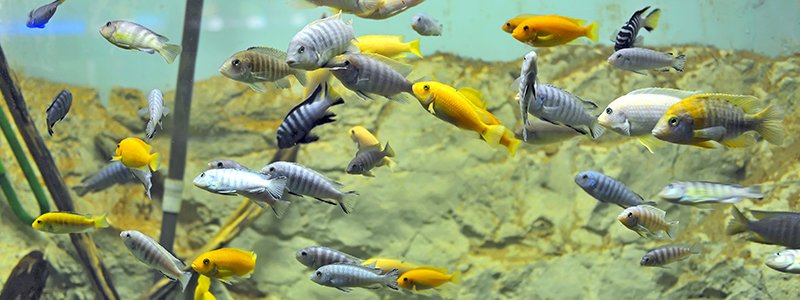
Here are a few of the best cichlid tank mates:
| Fish Species | Temperature Range | Characteristics | Size |
| Cichlid | 72-82˚ F | Semi-aggressive | Average 4-8 inches |
| Clown Loach | 72-86˚ F | Semi-aggressive, eat pest snails | Up to 12 inches |
| Plecostomus | 72-78˚ F | Peaceful, algae eaters | Up to 12 inches |
| Red Tail Shark | 72-79˚ F | Semi-aggressive, active fish | Up to 6 inches |
| Upside-Down Catfish | 71-79˚ F | Peaceful, algae eaters | Up to 4 inches |
| Raphael Catfish | 75-80˚ F | May eat any fish that will fit in its mouth | Up to 9 inches |
| Giant Danio | 70-75˚ F | Like to “play” with other fish | Average 4-6 inches |
It may be tempting to add cichlids to an existing tank instead of going through the process of having to set up a new tank. Let me warn you against that unless you’d like to see all your fish get eaten or bullied to death by the cichlids. The following species are especially vulnerable to cichlid aggression and should never ever be kept with cichlids:
- Corydoras
- Guppies
- Small tetras (neons, black neons, serpae tetras, etc.)
Even if you have an all-cichlid tank, you may still find them bullying each other. That’s one reason to add non-cichlid tankmates for your fish. They will be distracted by the other fish and more likely to leave each other alone.
One final note here: do not mix African cichlids with South or Central American cichlids. They tend to be aggressive toward one another and may actually spread diseases to each other.
If you’re not sure whether the fish you’d like to add to the tank will be compatible with your cichlids, always check with the knowledgeable staff at your local fish store.
6. Feeding Your Cichlids
Now that you know how to set up your tank and the types of fish that are compatible with cichlids, you need to know what to feed them.
Cichlids aren’t picky when it comes to food, and they’ll happily eat flake or pellet food. Switch up their feeding routine by giving them brine shrimp, bloodworms, or even algae wafers from time to time.
Click here to read my article on the top 5 cichlid foods.
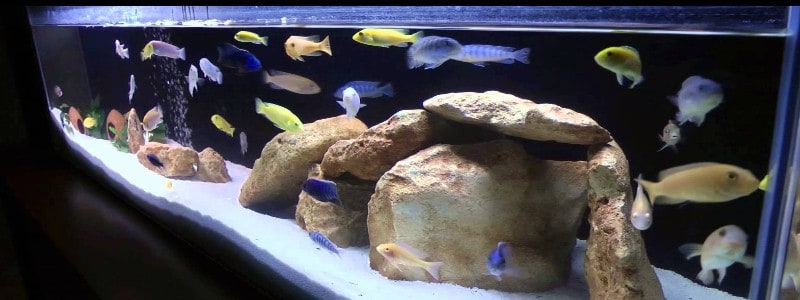
Depending on the species, your cichlid may also enjoy live food, including feeder fish, if the cichlids are on the larger end of the size spectrum.
If you do choose to feed your cichlids feeder fish, just be sure they don’t start to confuse their tankmates for their dinner!
In Summary: Are Cichlids Hard to Care For?
No, even if you’re a beginner, you can successfully keep cichlids by following the tips and tricks I’ve shown you. Just remember to:
- Get the right size tank for the number of fish you’re going to have
- Give your cichlids plenty of hiding places
- Make sure to have the right equipment to keep their tank clean and comfortable
- Keep the water pH neutral, or as close to neutral as possible
- Select appropriate tank mates
- Give them a variety of foods
If you do, you’ll be enjoying your cichlid tank for years to come!

